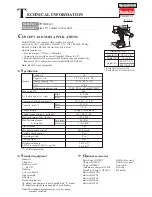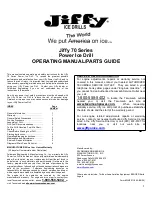
4
ENGLISH (Original instructions)
Explanation of general view
1-1. Red indicator
1-2. Button
1-3. Battery cartridge
2-1. Star marking
3-1. Switch trigger
4-1. Reversing switch lever
5-1. Lock button
5-2. Rotation with hammering
5-3. Action mode changing knob
6-1. Rotation only
7-1. Hammering only
8-1. Grip base
8-2. Side grip
8-3. Loosen
8-4. Tighten
8-5. Teeth
8-6. Protrusion
9-1. Bit shank
9-2. Bit grease
10-1. Bit
10-2. Chuck cover
11-1. Bit
11-2. Chuck cover
12-1. O symbol
12-2. Action mode changing knob
14-1. Depth gauge
15-1. Dust cup
17-1. Blow-out bulb
19-1. Chuck adapter
19-2. Keyless drill chuck
20-1. Sleeve
20-2. Ring
21-1. Limit mark
22-1. Screwdriver
22-2. Brush holder cap
SPECIFICATIONS
Model BHR241
Concrete 20
mm
Steel 13
mm
Capacities
Wood 26
mm
No load speed (min
-1
)
0 - 1,200
Blows per minute
0 - 4,000
Overall length
417 mm
Net weight
3.5 kg
Rated voltage
D.C. 18 V
• Due to our continuing programme of research and development, the specifications herein are subject to change without notice.
• Specifications and battery cartridge may differ from country to country.
• Weight, with battery cartridge, according to EPTA-Procedure 01/2003
ENE043-1
Intended use
The tool is intended for hammer drilling and drilling in
brick, concrete and stone as well as for chiselling work.
It is also suitable for drilling without impact in wood,
metal, ceramic and plastic.
ENG905-1
Noise
The typical A-weighted noise level determined according
to EN60745:
Sound pressure level (L
pA
) : 86 dB(A)
Sound power level (L
WA
) : 97 dB(A)
Uncertainty (K) : 3 dB(A)
Wear ear protection
ENG900-1
Vibration
The vibration total value (tri-axial vector sum)
determined according to EN60745:
Work mode : hammer drilling into concrete
Vibration emission (a
h,HD
) : 12.5 m/s
2
Uncertainty (K) : 1.5 m/s
2
Work mode : chiselling
Vibration emission (a
h,CHeq
) : 9.5 m/s
2
Uncertainty (K) : 1.5 m/s
2
Work mode: drilling into metal
Vibration emission (a
h,D
) : 2.5 m/s
2
or less
Uncertainty (K) : 1.5 m/s
2
ENG901-1
•
The declared vibration emission value has been
measured in accordance with the standard test
method and may be used for comparing one tool
with another.
•
The declared vibration emission value may also be
used in a preliminary assessment of exposure.
WARNING:
•
The vibration emission during actual use of the
power tool can differ from the declared emission
value depending on the ways in which the tool is
used.
•
Be sure to identify safety measures to protect the
operator that are based on an estimation of
exposure in the actual conditions of use (taking
account of all parts of the operating cycle such as
the times when the tool is switched off and when it
is running idle in addition to the trigger time).
Summary of Contents for BHR241
Page 53: ...53 ...
Page 54: ...54 ...
Page 55: ...55 ...
Page 56: ...56 Makita Corporation Anjo Aichi Japan www makita com 884838C984 ...





































